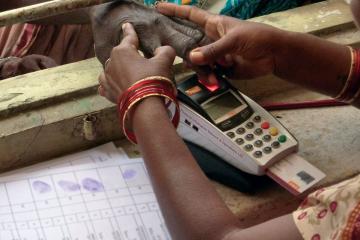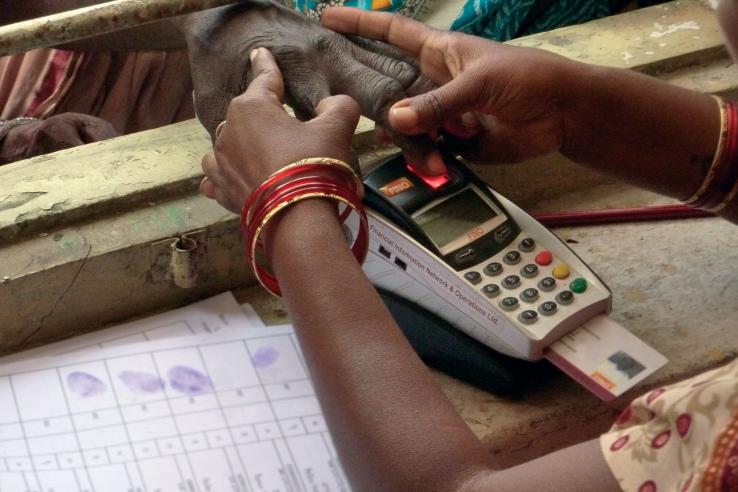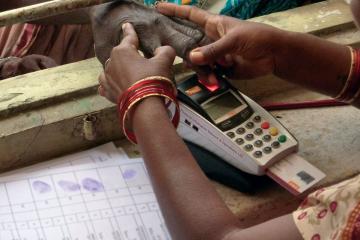
Smartcards for smarter payments: Improving state capacity in Andhra Pradesh

Across the world, developing country governments spend millions on anti-poverty programs and subsidies, yet this money often does not reach the poor. Funds can be diverted by corrupt officials, and funds that are not lost may reach the wrong recipients. For instance, in India, leakages from the country’s largest social welfare program have been estimated to be as high as 51 percent (Imbert and Papp 2016, unpublished).
An increasingly popular solution to these problems of corruption and exclusion are electronic payments systems with biometric authentication. These systems allow governments to deposit payments for subsidies or welfare programs directly into beneficiary bank accounts after verifying recipients’ identities through biometric authentication—in other words, using the unique biological characteristics of an individual, like her fingerprint, to verify that she is who she says she is. Streamlining fund-flows can prevent unexplained losses, and biometric authentication can help payments reach the right beneficiaries. But these systems can be costly, complex, difficult to implement, and prone to exclusion errors themselves (for instance, beneficiaries may find it difficult to enroll in the new payments system).
To shed light on the effectiveness of biometrically-authenticated payments systems, J-PAL affiliates Karthik Muralidharan (University of California, San Diego), Paul Niehaus (University of California, San Diego), and Sandip Sukhtankar (University of Virginia) partnered with the Government of Andhra Pradesh (GoAP), India to conduct a randomized evaluation of a new system targeting pension and public employment payments covering more than nineteen million people in the state.
To improve program delivery, GoAP introduced a new large-scale biometric payments system to deliver payments for a public employment program and a pensions program. In the previous system, beneficiaries would give paper identity documents to local officials to collect money on their behalf from branch post offices—a process prone to payment delays and corruption. In the new system, enrolled beneficiaries received biometrically-authenticated cards linked to bank accounts, known in the program as Smartcards, through which payments were deposited directly into the accounts. Payment logistics were contracted to private banks and customer service providers in each village, who were provided incentives to complete successful on-time payments.
In addition, GoAP agreed to phase the roll-out of the new system across 296 randomly assigned sub-districts, giving researchers the opportunity to measure the impact of the Smartcards on payment logistics, losses due to corruption and inefficiencies, and program access in one of the largest randomized evaluations on social programs ever conducted.
Researchers found that the new payments system had a large impact on reducing corruption and inefficiencies. While government spending on both programs did not change, beneficiaries reported receiving higher payments—implying a reduction of program losses by more than 40 percent. There was also a significant improvement in payment logistics: payments were released faster and took less time for beneficiaries to collect. Finally, there was no adverse impact on program access—actually, participation in the public employment program increased because of the smoother payment experience delivered through Smartcards.
Perhaps unsurprisingly, an overwhelming majority (more than 90 percent) of beneficiaries preferred the Smartcard system to the previous status quo. Researchers estimated that the economic gains for citizens from time-savings alone exceeded the cost of the new system. Adding in the savings from improved efficiency and reduced corruption, researchers estimated that Smartcards generated savings greater than US$40 million annually in eight districts.
Taken together, these results suggest that electronic payments systems with biometric authentication for recipients can improve the effectiveness of program delivery and reduce corruption—and do so without excluding beneficiaries.
More broadly, this experience highlights the importance of investing in state capacity and rigorously evaluating the rollout of large-scale government-run programs. Smartcards generated substantial cost savings, showing that there can be significant short-term returns to investments in improving program delivery. By evaluating the program, the government was able to generate and cite rigorous evidence clearly demonstrating the program’s effectiveness, enabling the program’s continued operation and expansion.
Since then, the results have informed a national policy on biometrically authenticated identification cards, further demonstrating the policy value of rigorous, large-scale evaluations.
To learn more about the intervention and results of the evaluation, read the J-PAL Briefcase.
